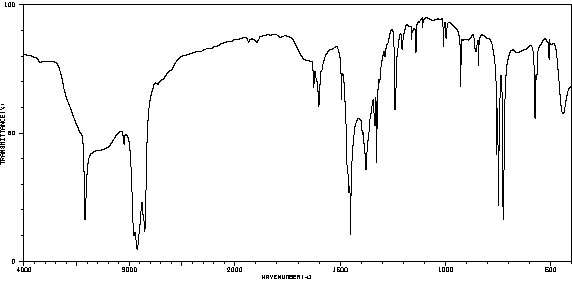potassium carbazole | 33650-07-6
中文名称
——
中文别名
——
英文名称
potassium carbazole
英文别名
potassium carbazolide;potassium carbazolate;potassium carbazol-9-ide;carbazole potassium salt;potassium 4aH-carbazol-4a-ide;potassium;carbazol-4a-ide
CAS
33650-07-6
化学式
C12H8KN
mdl
MFCD00070509
分子量
205.301
InChiKey
WTSKDGZCVMJGDJ-UHFFFAOYSA-N
BEILSTEIN
——
EINECS
——
-
物化性质
-
计算性质
-
ADMET
-
安全信息
-
SDS
-
制备方法与用途
-
上下游信息
-
文献信息
-
表征谱图
-
同类化合物
-
相关功能分类
-
相关结构分类
计算性质
-
辛醇/水分配系数(LogP):3.09
-
重原子数:14
-
可旋转键数:0
-
环数:3.0
-
sp3杂化的碳原子比例:0.0
-
拓扑面积:1
-
氢给体数:0
-
氢受体数:1
反应信息
-
作为反应物:参考文献:名称:Preparation of carbazolylsilanes摘要:DOI:10.1016/0022-328x(88)80377-2
-
作为产物:参考文献:名称:咔唑对环氧化物的区域选择性开环:直接制备新型 N-(β-羟烷基)咔唑摘要:研究了溶剂、碱和温度等参数对咔唑与环氧化物反应的影响。这导致了咔唑钾盐在 DMSO 中在 100 °C 下对环氧化物进行区域选择性开环的发展,这是制备新的 N-(β-羟烷基)咔唑的直接方法,收率良好至极好。描述了 15 种新化合物。DOI:10.3184/174751916x14538054606043
文献信息
-
Photochemical Decarboxylative C(sp<sup>3</sup>)–X Coupling Facilitated by Weak Interaction of N-Heterocyclic Carbene作者:Kun-Quan Chen、Zhi-Xiang Wang、Xiang-Yu ChenDOI:10.1021/acs.orglett.0c03006日期:2020.10.16still in its infancy. We demonstrate herein transition-metal-free decarboxylative C(sp3)–X bond formation enabled by the photochemical activity of the NHPI ester–NaI–NHC complex, giving primary C(sp3)–(N)phth, secondary C(sp3)–I, or tertiary C(sp3)–(meta C)phth coupling products. The primary C(sp3)–(N)phth coupling offers convenient access to primary amines.
-
Norbornene compounds with cross-linkable groups and their derivatives申请人:National Taiwan University of Science & Technology公开号:US07132565B2公开(公告)日:2006-11-07The present invention provided a norbornene compound with cross-linkable groups and their derivative polymers, wherein said cross-linkable groups were olefin or epoxy groups. Norbornene polymers with cross-linkable side chain and their block copolymers as well as modified derivatives were prepared via living ring-open metathesis polymerization method. The resulting polymers with excellent solubility and optic properties had narrow molecular weight distribution, well-controlled molecular weight, small refraction ration and high transparency. They were also suitable for preparing hybrid materials with high thermal stability and chemical resistance.
-
Organic heterobimetallic complexes of the alkaline earth metals (Ae = Ca, Sr, Ba) with tetrahedral metallate anions of three-valent metals (M = B, Al, Ga, and V)作者:Jens Langer、Sven Krieck、Helmar Görls、Günter Kreisel、Wolfgang Seidel、Matthias WesterhausenDOI:10.1039/c0nj00136h日期:——electropositive alkaline earth metals (Ae) and organic tetrahedral anions of trivalent elements (M) form solvent-separated ions. Depending on the metals, they can be prepared by addition of carbanions or amides to MR3, via reduction of VMes4 with the alkaline earth metals and by transmetallation of VMes3. For comparison reasons selected alkali metal derivatives are also included in this study. Average structural具有非常正电的碱土金属的复杂阳离子的异双金属化合物(e)和三价元素(M)的有机四面体阴离子形成溶剂分离的离子。取决于金属,可以通过向MR 3中添加碳负离子或酰胺,通过用碱土金属还原VMes 4以及通过VMes 3的金属置换来制备它们。出于比较的原因,本研究中还包括选定的碱金属衍生物。硼酸盐的平均结构参数[Ca(thf)6 ] [BPh 4 ] 2(1)和[CaI(thf)5 ] [BPh 4 ](2),铝酸盐[Li(thf)2(tmeda)] [AlPh 3(tmp)](3),[(thf)2 K(N-咔唑基)2 AlMes 2 ](4),以及[Sr(thf)7 ] [AlPh 4 ] 2(5),没食子酸盐[Ca(dme)4 ] [GaEt 3(N-咔唑基)] 2(6)和钒酸盐[Li(thf)4 ] [VMes 4 ](7),[ CaI (thf)5 ] [VMes 4 ](8),[Ca(thf)6
-
The [3,3′-Co(1,2-C2B9H11)2]– anion as a platform for new materials: synthesis of its functionalized monosubstituted derivatives incorporating synthons for conducting organic polymers作者:Jordi Llop、Carlos Masalles、Clara Viñas、Francesc Teixidor、Reijo Sillanpää、Raikko KivekäsDOI:10.1039/b211860m日期:2003.2.11[3,3â²-Co(8-C5H10O-1,2-C2B9H10)(1â²,2â²-C2B9H11)] (2) was synthesized by reaction of the caesium salt of [Co(C2B9H11)2]â with dimethyl sulfate in the presence of sulfuric acid as catalyst and tetrahydropyrane as solvent; the zwitterionic compound (2) yielded [3,3â²-Co(8-C4H4N-(CH2)5-O-1,2-C2B9H10)(1â²,2â²-C2B9H11)]â (6), [3,3â²-Co(8-C8H6N-(CH2)5-O-1,2-C2B9H10)(1â²,2â²-C2B9H11)]â (7), and [3,3â²-Co(8-C12H8N-(CH2)5-O-1,2-C2B9H10)(1â²,2â²-C2B9H11)]â (8) through the nucleophilic addition of potassium pyrrolyl, indolyl and carbazolyl, respectively. The nucleophilic addition of the same salts on [3,3â²-Co(8-C4H8O2-1,2-C2B9H10)(1â²,2â²-C2B9H11)] (1) yielded, respectively, [3,3â²-Co(8-C4H4N-(CH2)2-O-(CH2)2-O-1,2-C2B9H10)(1â²,2â²-C2B9H11)]â (3), [3,3â²-Co(8-C8H6N-(CH2)2-O-(CH2)2-O-1,2-C2B9H10)(1â²,2â²-C2B9H11)]â (4), and [3,3â²-Co(8-C12H8N-(CH2)2-O-(CH2)2-O-1,2-C2B9H10)(1â²,2â²-C2B9H11)]â (5). All these products were isolated, purified and characterized by means of 1H, 1H11B}, 11B, 11B1H} and 13C1H}-NMR and IR spectroscopies, MS MALDI-TOF spectrometry and elemental analysis. The behavior of the exo-cluster chain has been proven to be, in solution, very similar irrespective of the nucleophilic agent introduced into the molecule. The X-ray diffraction study of the potassium salt of 3 has proven the evidence of BâHâ¯K+ interactions in solid state. The 1H11B}-NMR spectra recorded in the range between 37 °C and â58 °C have proven the presence of the three intramolecular BâHâ¯K+ interactions in solution. The possible role of [Co(C2B9H11)2]â as a doping agent in conducting organic polymers is also discussed.[3,3'-Co(8-C5H10O-1,2-C2B9H10)(1',2'-C2B9H11)] (2) 通过使用硫酸作为催化剂和四氢吡喃作为溶剂,将[Co(C2B9H11)2]⁻的铯盐与二甲基硫酸反应合成。两性离子化合物 (2) 通过分别与吡咯基钾、吲哚基钾和咔唑基钾的亲核加成,产生了 [3,3'-Co(8-C4H4N-(CH2)5-O-1,2-C2B9H10)(1',2'-C2B9H11)]⁻ (6)、[3,3'-Co(8-C8H6N-( )5-O-1,2-C2B9H10)(1',2'-C2B9H11)]⁻ (7) 和 [3,3'-Co(8-C12H8N-( )5-O-1,2-C2B9H10)(1',2'-C2B9H11)]⁻ (8)。在 [3,3'-Co(8-C4H8O2-1,2-C2B9H10)(1',2'-C2B9H11)] (1) 上的相同盐的亲核加成分别产生了 [3,3'-Co(8- -( )2-O-( )2-O-1,2-C2B9H10)(1',2'-C2B9H11)]⁻ (3)、[3,3'-Co(8- -( )2-O-( )2-O-1,2-C2B9H10)(1',2'-C2B9H11)]⁻ (4) 和 [3,3'-Co(8- -( )2-O-( )2-O-1,2-C2B9H10)(1',2'-C2B9H11)]⁻ (5)。所有这些产物都被分离、纯化并通过 1H、1H11B}、11B、11B1H} 和 13C1H}-NMR 以及 IR 光谱学、MS MALDI-TOF 光谱学和元素分析进行了表征。无论引入分子中的亲核试剂如何,外簇链的行为在溶液中已被证明非常相似。钾盐3的X射线衍射研究表明,固态中的B-H…K+相互作用的证据。在37°C和-58°C之间记录的1H11B}-NMR光谱证实了溶液中存在三种分子内B-H…K+相互作用。还讨论了[Co(C2B9H11)2]⁻作为导电有机聚合物的掺杂剂的可能作用。
-
CARBENE COMPOUNDS AND ORGANIC ELECTROLUMINESCENT DEVICES申请人:UNIVERSITY OF SOUTHERN CALIFORNIA公开号:US20190161504A1公开(公告)日:2019-05-30A compound selected from the group consisting of Formula I, Formula II, and Formula III, wherein ring A, ring B, and ring C are independently a five-membered or six-membered, carbocyclic or heterocyclic ring, each of which is optionally aromatic; ring W of Formula I is a 6-membered heterocyclic ring, and ring W of Formula II or Formula III is a 5-membered or 6-membered heterocyclic ring; L is a monodentate ligand with a metal coordinating member selected from the group consisting of C, N, O, S, and P; and M is a metal selected from the group consisting of Cu, Au, and Ag.
表征谱图
-
氢谱1HNMR
-
质谱MS
-
碳谱13CNMR
-
红外IR
-
拉曼Raman
-
峰位数据
-
峰位匹配
-
表征信息
同类化合物
(Z)-3-[[[2,4-二甲基-3-(乙氧羰基)吡咯-5-基]亚甲基]吲哚-2--2-
(S)-(-)-5'-苄氧基苯基卡维地洛
(R)-(+)-5'-苄氧基卡维地洛
(R)-卡洛芬
(N-(Boc)-2-吲哚基)二甲基硅烷醇钠
(E)-2-氰基-3-(5-(2-辛基-7-(4-(对甲苯基)-1,2,3,3a,4,8b-六氢环戊[b]吲哚-7-基)-2H-苯并[d][1,2,3]三唑-4-基)噻吩-2-基)丙烯酸
(4aS,9bR)-6-溴-2,3,4,4a,5,9b-六氢-1H-吡啶并[4,3-B]吲哚
(3Z)-3-(1H-咪唑-5-基亚甲基)-5-甲氧基-1H-吲哚-2-酮
(3Z)-3-[[[4-(二甲基氨基)苯基]亚甲基]-1H-吲哚-2-酮
(3R)-(-)-3-(1-甲基吲哚-3-基)丁酸甲酯
(3-氯-4,5-二氢-1,2-恶唑-5-基)(1,3-二氧代-1,3-二氢-2H-异吲哚-2-基)乙酸
齐多美辛
鸭脚树叶碱
鸭脚木碱,鸡骨常山碱
鲜麦得新糖
高氯酸1,1’-二(十六烷基)-3,3,3’,3’-四甲基吲哚碳菁
马鲁司特
马鞭草(VERBENAOFFICINALIS)提取物
马来酸阿洛司琼
马来酸替加色罗
顺式-ent-他达拉非
顺式-1,3,4,4a,5,9b-六氢-2H-吡啶并[4,3-b]吲哚-2-甲酸乙酯
顺式-(+-)-3,4-二氢-8-氯-4'-甲基-4-(甲基氨基)-螺(苯并(cd)吲哚-5(1H),2'(5'H)-呋喃)-5'-酮
靛青二磺酸二钾盐
靛藍四磺酸
靛红联二甲酚
靛红磺酸钠
靛红磺酸
靛红乙烯硫代缩酮
靛红-7-甲酸甲酯
靛红-5-磺酸钠
靛红-5-磺酸
靛红-5-硫酸钠盐二水
靛红-5-甲酸甲酯
靛红
靛玉红衍生物E804
靛玉红3'-单肟5-磺酸
靛玉红-3'-单肟
靛玉红
靛噻
青色素3联己酸染料,钾盐
雷马曲班
雷莫司琼杂质13
雷莫司琼杂质12
雷莫司琼杂质
雷替尼卜定
雄甾-1,4-二烯-3,17-二酮
阿霉素的代谢产物盐酸盐
阿贝卡尔
阿西美辛杂质3







